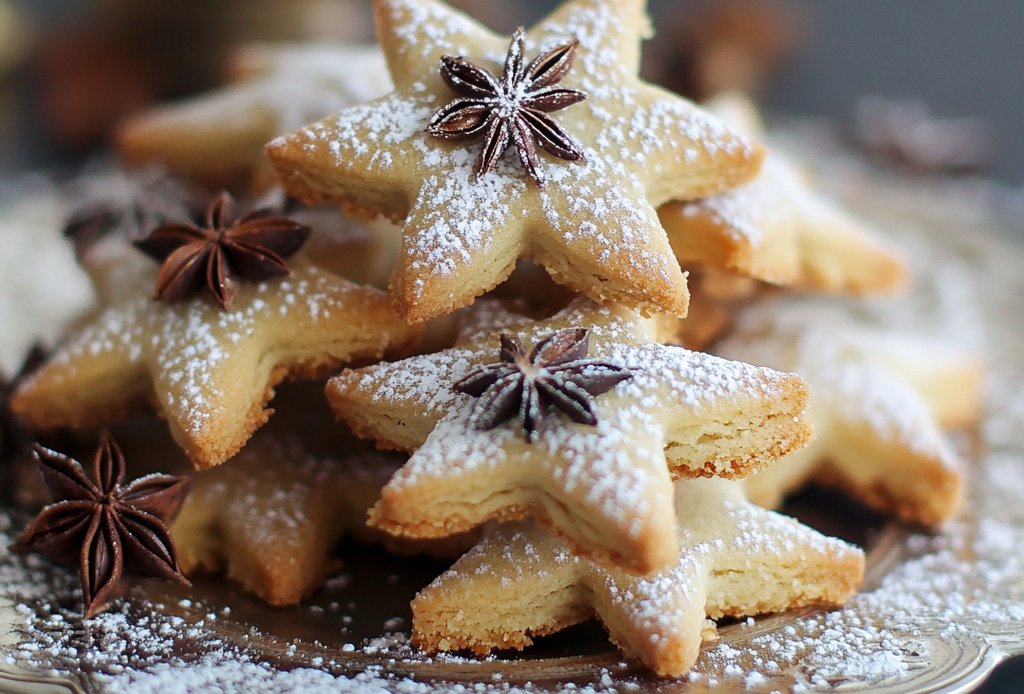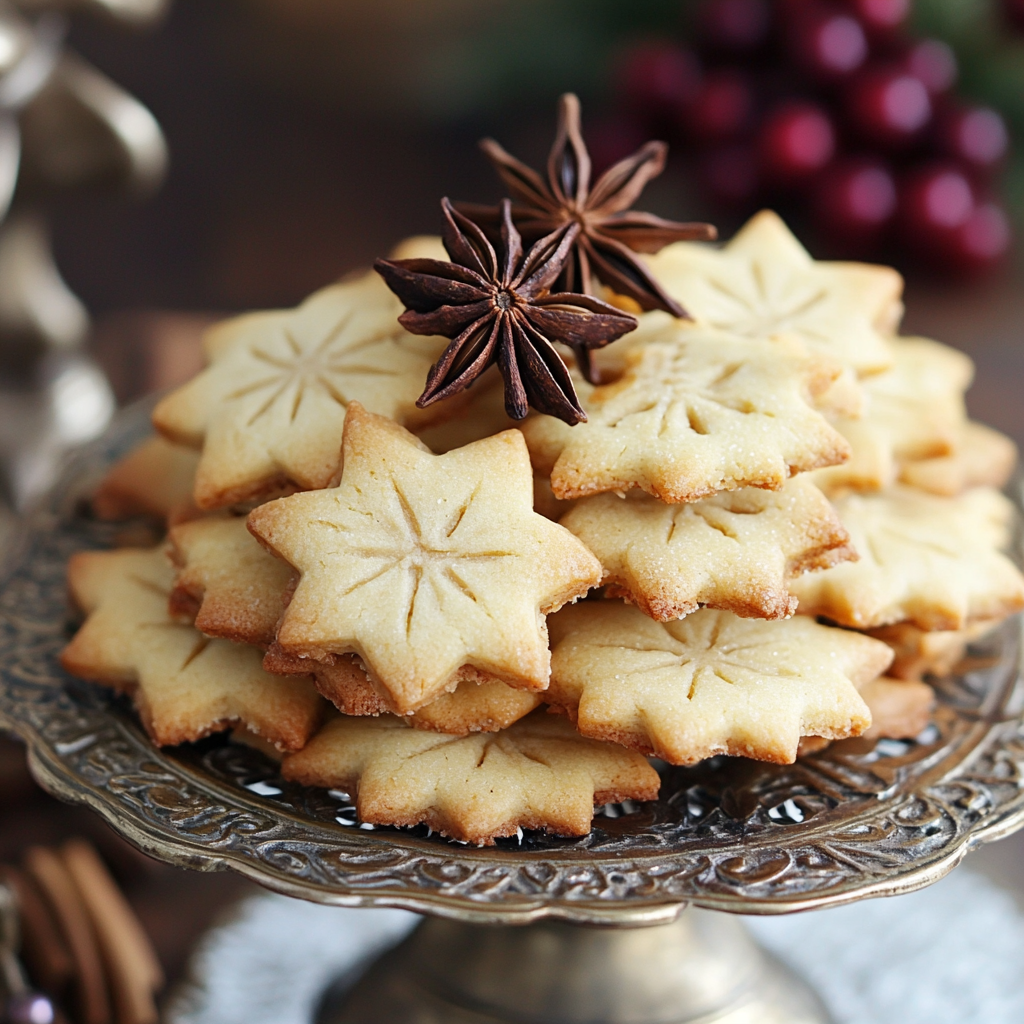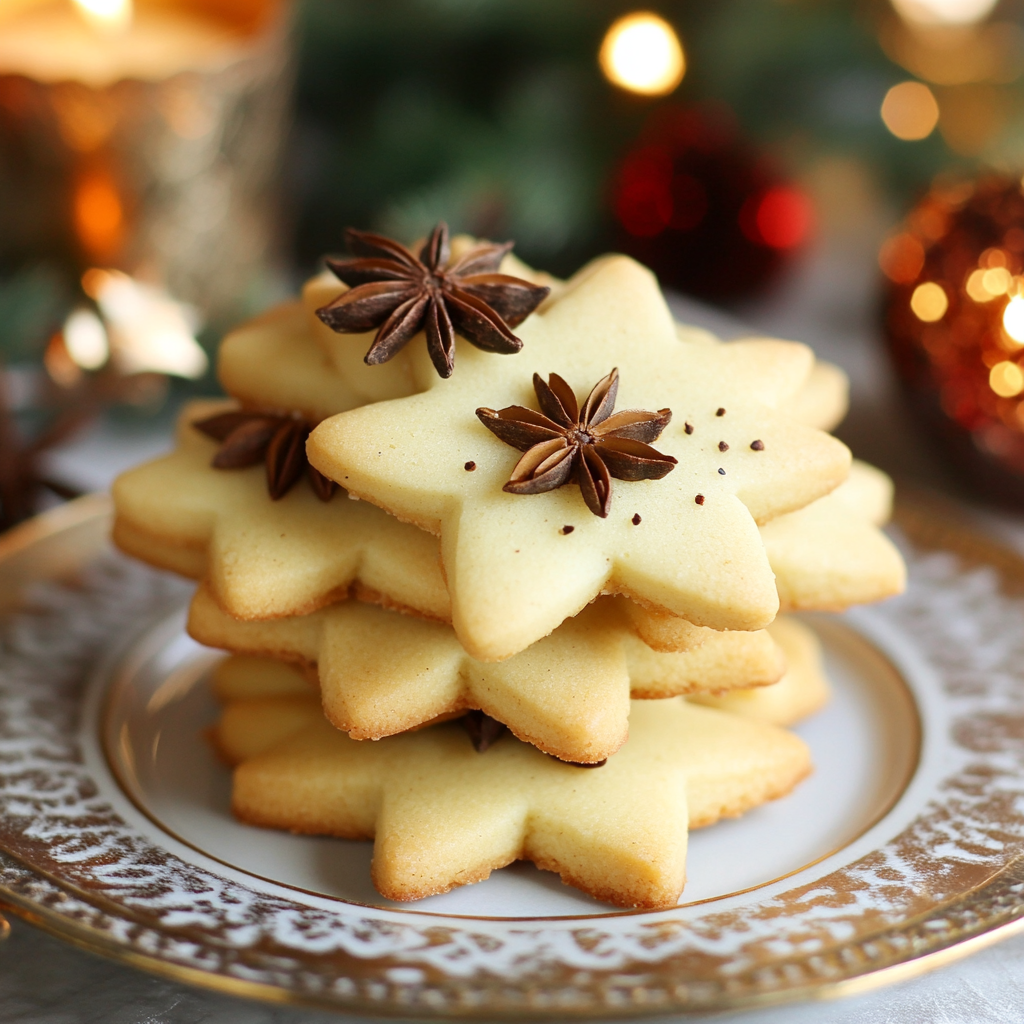
Every holiday, I remember walking into my grandmother’s kitchen. The smell of anise cookies was like a warm hug. It reminded me of her childhood in Italy and our family’s long history.
Today, making these cookies connects me to my heritage and brings joy. It shows how a simple recipe can link us to our past and to each other.
Key Takeaways
- Learn the iconic anise flavor and cultural roots of these classic treats.
- Discover step-by-step guidance for beginners and experienced bakers alike.
- Understand why anise cookies remain a global favorite for holidays and celebrations.
- Master techniques to ensure perfect texture and aroma every time.
- Explore tips for decorating and storing to preserve freshness and beauty.

Whether you’re making a family recipe or trying anise cookies for the first time, this guide helps. You’ll learn how to make cookies that taste like love. Maybe they’ll even start new traditions for you.
What Are Anise Cookies?
Anise cookies are loved all over the world for their unique licorice-like flavor. They mix anise seeds or extracts with common baking ingredients. This creates a taste that’s both known and exciting.
The Distinct Flavor Profile of Anise
Anise’s special taste comes from anethole, found in its seeds. This compound makes anise cookies smell sweet and peppery, like licorice. “The warmth of anise balances sweetness, making it a timeless baking ingredient,” says pastry chef Elena Rivera. Bakers add ground seeds or extracts to doughs to bring out this flavor.
Cultural Significance of Anise in Baking
Many cultures celebrate anise in their traditions. For example:
| Culture | Cookie Type | Symbolism |
|---|---|---|
| Italian | Biscotti all’Anice | Served with coffee during festivals |
| Mexican | Cookies de Anís | Gifted during Christmas |
| German | Pfeffernüsse | Winter holiday treats |
Popular Varieties Around the World
- Italian Biscotti: Twice-baked with anise and almonds.
- German Springerle: Imprinted designs with anise-scented dough.
- Mexican Wedding Cookies: Crumbly shortbread infused with anise.
Each variety uses anise in a way that fits local tastes. This shows how versatile anise is in kitchens everywhere.
The History and Origins of Traditional Anise Cookies
Anise has been used in baking for thousands of years. Ancient Egyptians used it in their ceremonial breads. Roman cooks mixed it with honey in cakes. These early anisette cookie recipes have evolved into the treats we love today.
Trade routes spread anise seeds across the world. They carried culinary traditions to medieval Europe. This spread anise’s use in baking.
In the Middle Ages, anise became a symbol of celebration. In Germany, the anisette cookie recipe for Springerle was born. It used carved molds to create intricate designs on dough with crushed anise seeds.
These cookies were a big hit at festivals and weddings. Their designs often showed religious or seasonal themes.
- 1500s: Anise seeds traveled via spice traders, blending with local ingredients in France and Italy.
- 1700s: German immigrants brought Springerle recipes to the U.S., adapting them with regional flavors.
- Today: Traditional methods persist, though modern bakers tweak recipes to balance classic and contemporary tastes.
Today, bakers still use hand-carved molds and slow-baking methods. Ingredients like butter or sugar may change by region. But the core flavor of anise remains the same—a timeless link to ancient traditions.
Essential Ingredients for Perfect Anise Cookies
To make great anise cookies, start with the right ingredients. Each one affects the taste, texture, and look of these classic treats.
Understanding Anise Extract vs. Anise Oil
Anise extract is perfect for beginners, offering a balanced flavor. Use 1 teaspoon in most recipes. For a stronger taste, try pure anise oil, but use only ½ teaspoon to avoid too much flavor.
Extract mixes well with other ingredients. Oil, on the other hand, gives a bold, licorice taste.
Flour and Leavening Agents
All-purpose flour makes cookies sturdy, while cake flour makes them softer. Pick one based on the texture you want:
- All-purpose flour: 2 cups for crispier results
- Cake flour: 1¾ cups plus 2 tablespoons for a tender crumb
Baking powder helps the dough rise. Baking soda works with acidic ingredients like buttermilk. Too much of either can make cookies flat.
Sweeteners and Fats
Sweeteners and fats change how cookies taste and feel. Here’s what to use:
- Granulated sugar: For crisp edges and classic sweetness
- Powdered sugar: Adds tenderness but requires reduced oven time
Butter adds richness. Shortening is a good substitute for a neutral taste. Honey can replace up to ¼ of the sugar for moisture, but you might need to adjust baking soda since it’s acidic.
Kitchen Equipment You’ll Need
To make an anisette cookie recipe, you need the right tools. This guide helps both new and experienced bakers. It covers the must-haves and some creative workarounds.
Baking Tools and Alternatives
Begin with the basics: a mixing bowl, measuring cups, and a spatula. A stand mixer can mix dough fast, but a wooden spoon works great too. For even baking, parchment-lined baking sheets are best. If you don’t have those, silicone mats are a good substitute.
A cooling rack is key to prevent soggy cookies. If you don’t have one, a wire rack or a wire-mesh colander will do.
- Mixing bowls: Stainless steel or glass bowls are best.
- Measuring cups: You’ll need both dry and liquid sets for exact measurements.
- Rolling pin: A standard pin is fine, but a textured one adds a special touch.
Cookie Cutters and Molds
For a traditional anisette cookie recipe, Springerle molds are perfect. These molds make intricate patterns when you roll and press the dough. If you can’t find Springerle molds, Wilton offers star and crescent cutters.
For a simple look, roll the dough thin and cut it with a knife. This way, you don’t need special molds.
Tip: Dust molds with flour before adding dough for easy release. You can find Springerle boards online or at baking shops. They’re not expensive. For easy cleanup, try silicone molds.
Step-by-Step Anise Cookies Recipe
Learn to make classic anise cookies with this easy guide. It’s perfect for all bakers, from beginners to experts.
| Ingredients | US Standard | Metric |
|---|---|---|
| Unsalted butter | 1 cup (2 sticks) | 226g |
| Granulated sugar | ½ cup | 100g |
| Anise extract | 2 tsp | 10ml |
| All-purpose flour | 3 cups | 375g |
| Baking powder | 1 tsp | 5g |
| Salt | ¼ tsp | 1.25g |
- Mix softened butter and sugar until light and fluffy. Add anise extract, mixing until combined (2 mins).
- In a separate bowl, whisk flour, baking powder, and salt. Gradually blend into the wet mixture until a smooth dough forms.
- Wrap dough in parchment and chill for 1 hour (critical for shaping).
- Preheat oven to 325°F (160°C). Roll dough ¼” thick on a floured surface. Cut shapes with molds or cutters.
- Bake 12-15 mins until edges just begin to brown. Cool on a rack 10 mins before serving.
| Phase | Time | Note |
|---|---|---|
| Prep | 20 mins | Active mixing and prep work |
| Chill | 1 hour | Essential for proper shaping |
| Bake | 15 mins | Watch edges closely to avoid overbrowning |
| Total | ~2 hours 15 mins | Includes cooling time |
Pro tip: For the best texture, use room-temperature butter. This ensures even anise flavor. Avoid overmixing to prevent dense cookies.
Mixing and Preparing the Dough
Perfect anise cookies start with a well-prepared dough. Mastering the mixing process ensures the right balance of flavor and texture. Follow these steps to avoid common pitfalls and achieve professional results.
Proper Techniques for Incorporating Anise
Choosing the right anise integration method shapes the final taste:
- Infuse anise extract into softened butter for even distribution.
- Bloom ground anise seeds in warm milk to unlock aromatic oils.
- Steep whole star anise in hot water, strain, then blend into the batter for subtle depth.
Extracts add sharp flavor instantly, while seeds and whole spices build layered notes. Overmixing risks overdeveloping gluten, so stir gently after adding anise components.
Achieving the Right Consistency
Test dough texture by shaping into a ball. If it cracks, add 1 tsp milk. If too sticky, refrigerate for 10 minutes. Ideal dough holds shape without clinging to fingers. Avoid adding too much flour—most issues stem from incorrect liquid ratios.
Chilling Tips for Better Results
Chill dough 2–4 hours (or 1 hour in the freezer) to relax gluten strands. Wrap tightly in parchment paper to prevent drying. Chilled dough cuts cleaner and bakes evenly, enhancing the signature anise aroma. For intense flavor, chill overnight—this allows spices to meld fully.
Baking Tips for Crisp Yet Tender Anise Cookies
To get anise cookies with crisp edges and a soft center, focus on the baking stage. Preheat your oven to 325°F (160°C). Place racks in the center for even baking.
Roll the dough to a uniform 1/4-inch thickness. Use a ruler to space cookies 2 inches apart. This helps them bake evenly. Adjust the pressure of your rolling pin for consistent results.
- Spreading Too Much: Chill the dough for 30 minutes before baking. This helps the fats firm up and prevents spreading.
- Uneven Browning: Rotate pans halfway through baking. Dark pans absorb heat faster. Line them with parchment to avoid overbrowning.
- Overbrowning: Check cookies 2–3 minutes early. Edges should be pale golden. Centers will firm up as they cool.
Watch for visual cues: edges harden first, but centers stay soft until fully baked. Overbaked cookies lose their anise flavor. Let cookies sit on the pan 2–3 minutes before transferring to a rack to avoid breaking.
Use silicone mats or parchment to prevent sticking and promote even crispness. Avoid insulated sheets if you want golden edges. Adjust baking time based on your oven’s performance.
Authentic German Anise Cookies Variation

German anise cookies, known as Springerle, carry centuries of tradition in every crisp bite. These delicate cookies originated in southern Germany. They use carved molds to imprint intricate designs that rise during baking.
The process starts with a dough enriched with anise. But, a unique twist is added: hartshorn (ammonium carbonate) provides its signature airy texture.
Traditional Springerle Method
Mastering Springerle requires patience. Key steps include:
- Mix dough with hartshorn (or baking powder as a modern substitute)
- Roll dough thin and press into carved wooden molds
- Let dough dry overnight to prevent design distortion
- Bake at low heat for a translucent, lace-like appearance
These anise cookies german often feature scenes of saints, animals, or seasonal motifs. They are cherished heirlooms.
Regional German Variations
German regions adapt Springerle recipes to local tastes:
| Region | Key Ingredients | Signature Traits |
|---|---|---|
| Swabia | Ground anise, hartshorn | Crystalline translucence, floral molds |
| Bavaria | Dark molasses, citrus zest | Deep flavor, geometric patterns |
| North Germany | Potash, caraway seeds | Earthy undertones, simpler molds |
Modern bakers often use silicone molds or substitute hartshorn for safety. Yet, they retain the anise-forward profile. These cookies remain staple treats at German Christmas markets and family celebrations. They bridge old-world charm with contemporary kitchens.
Decorating and Glazing Options
Finishing touches can make a big difference in your anisette cookies. Add flavor and beauty with these decorating tips. Start with a classic glaze and then try out some creative designs.
Simple Anise Glaze Recipe
To make a smooth glaze, mix 1 cup powdered sugar, 1-2 tsp milk, and ¼ tsp anise extract. Adjust the mix to make it thinner for drizzling or thicker for spreading. Apply it to warm cookies for a soft glaze or wait until they cool for a crisp finish.
Let the glaze dry on a rack for 2-3 hours. This prevents it from cracking.
Festive Decoration Ideas
Turn simple anisette cookies into something special with these ideas:
- Add festive colors with sugar crystals—red and green for Christmas, gold for Hanukkah, or pastels for Easter.
- For elegance, layer edible gold leaf or silver dust. Use a soft brush to press it on.
- Use stencils to pipe cocoa powder or icing into fun patterns.
- Adding lemon or orange zest brings brightness, while cinnamon or nutmeg deepens the scent.
Match your decorations with the season: star shapes for winter or floral designs for spring. Let your creativity meet tradition to showcase your anisette cookie recipe’s heritage.
Storing and Preserving Your Anise Cookies
Keeping anise cookies fresh is easy. First, cool them completely on a wire rack. This step prevents moisture buildup, which can make them soft.
- Containers: Use airtight glass jars or metal tins for long-term storage. Plastic containers work too, but avoid those with odors that might seep into the cookies.
- Temperature: Store at room temperature (68–72°F) in a dry spot. Refrigerate only if humidity is high, but wrap tightly to prevent freezer burn.
- Shelf Life: At room temp, anise cookies stay fresh 1–2 weeks. Refrigerated, they last 3–4 weeks. Frozen, they keep up to 3 months in heavy-duty freezer bags.
“In Germany, traditional Springerle anise cookies are stored in linen-lined boxes to let flavors mature over time,” notes the German Bakers’ Guild. “Their licorice notes deepen when aged properly.”
To keep cookies crunchy, layer them with parchment. For a softening trick, add a slice of apple or bread to the container. This will soften them overnight. Check containers for condensation often; if you see it, air them out and repackage.
Freezing? Double-wrap in parchment and foil before freezing. Thaw at room temperature in sealed containers to retain crunch. Avoid mixing batches in one container to prevent uneven texture changes.
Serving Suggestions and Pairings
Anise cookies german are more than snacks—they connect cultures. In Germany, they’re a hit during holidays like Christmas. They’re part of festive platters called Bunter Teller.
Families share them in Advent calendars or as gifts. They symbolize warmth and tradition.
Holiday Traditions Featuring Anise Cookies
German celebrations often include Springerle cookies with intricate designs. These anise cookies german are enjoyed with seasonal activities. Baking with children or exchanging homemade batches with neighbors is common.
At Christmas markets, they’re sold alongside gingerbread. This shows the joy of sharing with the community.
Complementary Beverages
Here are some drinks that pair well with anise cookies german:
- Glühwein: The warm spices in mulled wine complement the licorice notes of the cookies.
- Dark hot chocolate: Rich cocoa balances the herbaceous flavor.
- Coffee with cream: The dairy softens the anise’s sharpness.
In Germany, these pairings are based on enhancing flavors. Serve cookies with a steaming cup of coffee or Glühwein. This honors centuries-old traditions. Whether at a holiday party or a casual gathering, these combinations create memorable moments.
Conclusion
Learning to make anise cookies opens a door to a world where tradition and taste come together. German anise cookies, like Springerle, carry centuries of history in every bite. Each step, from picking ingredients to perfecting the dough, honors techniques passed down through generations.
These treats become family heirlooms when shared during holidays or casual moments. They bridge past and present. Precision in baking, whether shaping dough or applying glaze, ensures results that mirror time-honored recipes.
The patience needed in chilling dough or adjusting oven times is worth it. Cookies that balance crispness and anise’s signature warmth are the result. German traditions like Springerle show that even small details matter, turning ingredients into cultural stories.
Anise cookies german-style are a way to celebrate heritage while making new memories. Your kitchen becomes a link in a chain of bakers. This shows that tradition can inspire both comfort and creativity.
With every batch, you keep culinary history alive while enjoying flavors that span continents and eras.
FAQ
What are anise cookies, and what makes them special?
Anise cookies are sweet treats with a licorice-like taste. They’re loved for their unique flavor and cultural importance. This makes them a favorite during holidays.
How do I make anisette cookies from scratch?
To make anisette cookies, you need anise extract, flour, sugar, and butter. Mix these ingredients, shape the dough, and bake until golden. Try traditional methods or variations like German springerle for a unique touch.
Can I use anise oil instead of anise extract in recipes?
Yes, you can use anise oil instead of extract. But remember, anise oil is stronger. Use less oil to avoid overpowering the cookies.
What are some common variations of anise cookies around the world?
Anise cookies vary worldwide. In Italy, they’re biscotti. In Mexico, they’re in wedding cakes. Germany has traditional springerle cookies with intricate molds.
How should I store my anise cookies to keep them fresh?
Keep anise cookies fresh by cooling them completely. Store them in airtight containers like metal tins or glass jars. For longer storage, freeze them for up to three months.
What beverages pair well with anise cookies?
Anise cookies pair well with drinks like glühwein, hot chocolate, or creamy coffee. The licorice flavor in anise complements these drinks, making the taste experience better.




